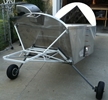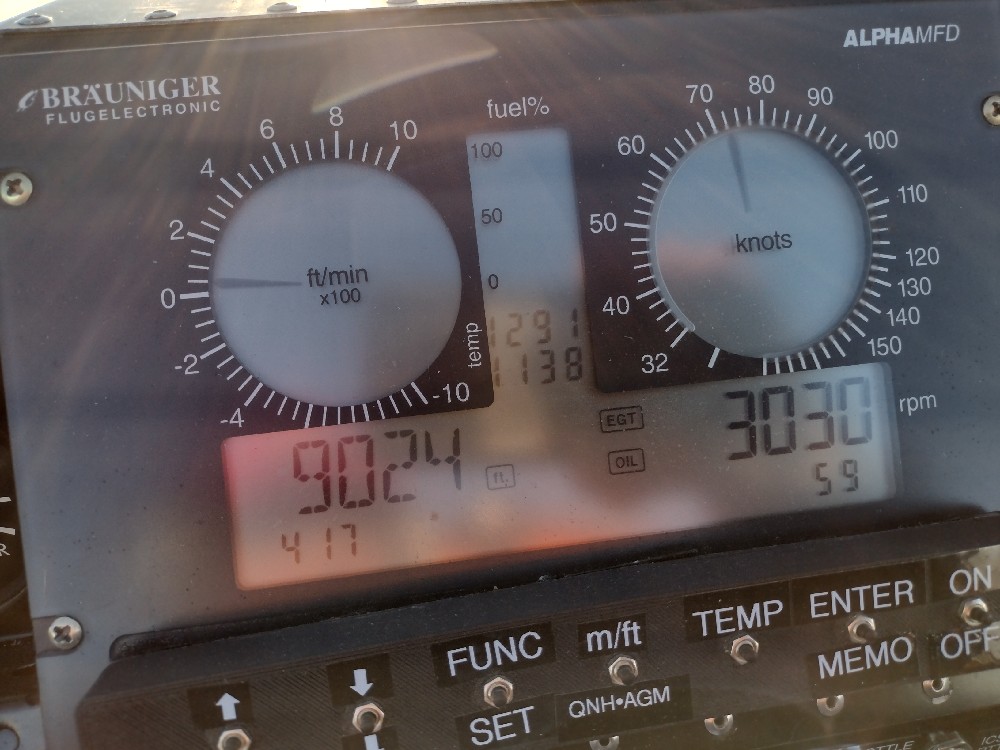


random user submitted photo
Balloon Intercept – the Real Story
11 posts
• Page 1 of 2 • 1, 2
Balloon Intercept – the Real Story
It can now be revealed that the shoot down of the Chinese balloon on 4th February 2023 was not performed by a $334 million 5th Generation F-22 Raptor. In fact the public’s perceived delay in the response from the Department of Defense was caused by an Air Force crash program to equip an EXPERIMENTAL aircraft to perform the mission much more cheaply.
As the balloon first tracked in across Alaska the author was approached to see if it might be possible to equip an EXPERIMENTAL aircraft to tackle the balloon. The author agreed to adapt an AeroVee powered Legacy model Sonex with some enhancements to see if it could perform the intercept.
Starting with the Sonex VNe of 197mph – it was determined that if the plane could be made to vertically climb if could reach an operating altitude of 55,000ft in 3min and 10 sec. In this manner the plane could be used as a point interceptor in the style of the old Royal Air Force English Electric Lightning.
It was assumed that the non-turbo Aerovee could be boosted in some manner to provide the power. Looking through the parts bin the author was inspired by an old WWII oxygen bottle.
A visit to the local WalMart provided a Nitro Kit from the car accessory aisle. To save time with plumbing, the plane’s smoke system was removed and the plumbing utilized for the gases.
The bottles were bolted down in the passenger seat to avoid problems with center of gravity and a new weight and balance was calculated as no one could find find the calibrated scales to weigh the plane. This work took a couple of days while the balloon drifted across the mid-West. The idea of obtaining some hypergolic fuels to inject into the exhaust was also explored – but safety issues for the pilot precluded their use. However a large bottle of Hydrogen Peroxide was taken from the First Aid kit in the shop to drip into the system to boost performance further.
Reading about possible physiological issues that might be encountered the pilot went on a low fibre diet to prevent problems with intestinal gases during the rapid climb. Reading about WWII pilots confirmed that if the pilot could “tough it out” for 10 mins or so – the rapid loss of pressure would not cause a fatal case of “the bends” though it would be important to “get back down” as fast as possible after reaching altitude in order to not cause permanent damage. A training session on the FAA PROTE – Portable Reduced Oxygen Training Enclosure confirmed that the pilot’s useful conscious time was 2 min and 30 secs before hypoxia set in. Deep breathing exercises prior to initiating the climb could extend this by an addition 45 secs – after which the pilot would pass out. Between the 3 min 10 sec climb and the 3 min 15 sec usable consciousness after passing 12,500ft, this gave the pilot about 15 secs to acquire and down the target at FL55.
An emergency application was made to the local FSDO asking for the aircraft’s Phase 1 test area to be moved to 333615N/0784614W - 334244N/0783657W - 333459/N0782914W - 332831N/0783821W and with the help of a friendly FAA inspector this work was expedited. However a request to remove the prohibitions in the Operation Limitations on the fitting of hardpoints was denied. The Department of Defense agreed to class the Sonex as a “National Security Aircraft” to avoid a TFR bust when the airspace was closed for the mission.
It was agreed that as long as the aircraft did not use the engine modifications during a ferry flight – it could be operated in Phase 2 and this facilitated the delivery to South Carolina just before the balloon drifted out of range.
In the event – the TFR was put in place on the 4th Feb and the Sonex launched from one of the airports from within the TFR. Local ATC issued a Special VFR clearance as the aircraft was not IFR equipped. The pilot reported that after turning the valves on the Nitro and Oxygen bottles the plane “went vertical” and it took a lot of rudder and aileron to counteract “P” factor and torque induced roll. The Aerovee redlines at 3,400rpm and the instrumentation could not record the actual engine speed – but the pilot stated that it was “very fast”. The pilot believes that it was so fast that all engine valves were effectively simultaneously open and an effect similar to reheat was taking place in the tail pipes. Aiming straight at the middle of the balloon – the wood/carbon Prince “P-Tip’s” hooked the balloon to pieces.
The Air Force stated they were entirely satisfied with the intercept. A spokesperson said that even though they were going to be out the costs of a new AeroVee engine kit, a propeller, the Nitro kit, some AvGas and a few beers – “it was a lot cheaper than a $431,000 Sidewinder missile.”
The pilot was not available for immediate comment as they were trying to stop their nose bleeding.
As the balloon first tracked in across Alaska the author was approached to see if it might be possible to equip an EXPERIMENTAL aircraft to tackle the balloon. The author agreed to adapt an AeroVee powered Legacy model Sonex with some enhancements to see if it could perform the intercept.
Starting with the Sonex VNe of 197mph – it was determined that if the plane could be made to vertically climb if could reach an operating altitude of 55,000ft in 3min and 10 sec. In this manner the plane could be used as a point interceptor in the style of the old Royal Air Force English Electric Lightning.
It was assumed that the non-turbo Aerovee could be boosted in some manner to provide the power. Looking through the parts bin the author was inspired by an old WWII oxygen bottle.
A visit to the local WalMart provided a Nitro Kit from the car accessory aisle. To save time with plumbing, the plane’s smoke system was removed and the plumbing utilized for the gases.
The bottles were bolted down in the passenger seat to avoid problems with center of gravity and a new weight and balance was calculated as no one could find find the calibrated scales to weigh the plane. This work took a couple of days while the balloon drifted across the mid-West. The idea of obtaining some hypergolic fuels to inject into the exhaust was also explored – but safety issues for the pilot precluded their use. However a large bottle of Hydrogen Peroxide was taken from the First Aid kit in the shop to drip into the system to boost performance further.
Reading about possible physiological issues that might be encountered the pilot went on a low fibre diet to prevent problems with intestinal gases during the rapid climb. Reading about WWII pilots confirmed that if the pilot could “tough it out” for 10 mins or so – the rapid loss of pressure would not cause a fatal case of “the bends” though it would be important to “get back down” as fast as possible after reaching altitude in order to not cause permanent damage. A training session on the FAA PROTE – Portable Reduced Oxygen Training Enclosure confirmed that the pilot’s useful conscious time was 2 min and 30 secs before hypoxia set in. Deep breathing exercises prior to initiating the climb could extend this by an addition 45 secs – after which the pilot would pass out. Between the 3 min 10 sec climb and the 3 min 15 sec usable consciousness after passing 12,500ft, this gave the pilot about 15 secs to acquire and down the target at FL55.
An emergency application was made to the local FSDO asking for the aircraft’s Phase 1 test area to be moved to 333615N/0784614W - 334244N/0783657W - 333459/N0782914W - 332831N/0783821W and with the help of a friendly FAA inspector this work was expedited. However a request to remove the prohibitions in the Operation Limitations on the fitting of hardpoints was denied. The Department of Defense agreed to class the Sonex as a “National Security Aircraft” to avoid a TFR bust when the airspace was closed for the mission.
It was agreed that as long as the aircraft did not use the engine modifications during a ferry flight – it could be operated in Phase 2 and this facilitated the delivery to South Carolina just before the balloon drifted out of range.
In the event – the TFR was put in place on the 4th Feb and the Sonex launched from one of the airports from within the TFR. Local ATC issued a Special VFR clearance as the aircraft was not IFR equipped. The pilot reported that after turning the valves on the Nitro and Oxygen bottles the plane “went vertical” and it took a lot of rudder and aileron to counteract “P” factor and torque induced roll. The Aerovee redlines at 3,400rpm and the instrumentation could not record the actual engine speed – but the pilot stated that it was “very fast”. The pilot believes that it was so fast that all engine valves were effectively simultaneously open and an effect similar to reheat was taking place in the tail pipes. Aiming straight at the middle of the balloon – the wood/carbon Prince “P-Tip’s” hooked the balloon to pieces.
The Air Force stated they were entirely satisfied with the intercept. A spokesperson said that even though they were going to be out the costs of a new AeroVee engine kit, a propeller, the Nitro kit, some AvGas and a few beers – “it was a lot cheaper than a $431,000 Sidewinder missile.”
The pilot was not available for immediate comment as they were trying to stop their nose bleeding.
Graeme JW Smith
-

GraemeSmith - Posts: 939
- Joined: Sat May 18, 2019 8:58 am
- Location: RI
Re: Balloon Intercept – the Real Story
Graeme, do you always have trouble sleeping on March 32nd?
Wayne, Oshkosh, Sonex N444SX, Conventional gear, Jab 3300, Enigma
- Oshpilot
- Posts: 46
- Joined: Wed Aug 21, 2013 10:25 pm
- Location: Oshkosh, WI
Re: Balloon Intercept – the Real Story
When you posted the original picture I figured it was a hoax. But with nitrous and hydrogen peroxide now it makes sense. Did you up your gross weight to 1150?
Bryan Cotton
Poplar Grove, IL C77
Waiex 191 N191YX
Taildragger, Aerovee, acro ailerons
dual sticks with sport trainer controls
Prebuilt spars and machined angle kit
Year 2 flying and approaching 200 hours December 23
Poplar Grove, IL C77
Waiex 191 N191YX
Taildragger, Aerovee, acro ailerons
dual sticks with sport trainer controls
Prebuilt spars and machined angle kit
Year 2 flying and approaching 200 hours December 23
-

Bryan Cotton - Posts: 5489
- Joined: Mon Jul 01, 2013 9:54 pm
- Location: C77
Re: Balloon Intercept – the Real Story
Graeme JW Smith
-

GraemeSmith - Posts: 939
- Joined: Sat May 18, 2019 8:58 am
- Location: RI
Re: Balloon Intercept – the Real Story
I hope you post this on face book so that everyone can realise this is how it actually happened....
Murray Parr
WXB0015
Rotax 912ULS
MGL Explorer Lite
First flight May 6/23
RV9 builder (Sold)
WXB0015
Rotax 912ULS
MGL Explorer Lite
First flight May 6/23
RV9 builder (Sold)
- Murray Parr
- Posts: 248
- Joined: Fri Nov 18, 2016 6:50 pm
Re: Balloon Intercept – the Real Story
I have always appreciated the skills of a great bullshit artist...Graeme, you are the genuine article!
Just a crazy thought, what is the highest anyone has flown their Sonex? The highest that I've gone is just over 8500 feet, naturally I'd left my warm jacket on the seat next to me and froze my arse off. Normally I'm flying under Class C airspace and to go higher means a bit of travel first. Legally I can't go over 10,000 feet here in Australia, but I was wondering if anyone has tried going higher just for the hell of it.
Just a crazy thought, what is the highest anyone has flown their Sonex? The highest that I've gone is just over 8500 feet, naturally I'd left my warm jacket on the seat next to me and froze my arse off. Normally I'm flying under Class C airspace and to go higher means a bit of travel first. Legally I can't go over 10,000 feet here in Australia, but I was wondering if anyone has tried going higher just for the hell of it.
Richard
Scratch build Sonex
Std gear, dual control
Jabiru 3300, Sensenich prop
19-8776
1st Flight 25th June 2019. 170 hrs so far.....
http://www.sonex1566.com
Scratch build Sonex
Std gear, dual control
Jabiru 3300, Sensenich prop
19-8776
1st Flight 25th June 2019. 170 hrs so far.....
http://www.sonex1566.com
- sonex1566
- Posts: 94
- Joined: Thu Jun 21, 2018 6:11 am
Re: Balloon Intercept – the Real Story
Graeme is a good reporter but a crappy Investigative reporter. The entire story is informative and all, but who pocketed the money difference? Some Gov't Bean Counter is having a hernia over the missing funds. That's the REAL story taxpayers want.
- Scott Todd
- Posts: 374
- Joined: Mon Jun 24, 2019 7:40 pm
- Location: Chandler, AZ
Re: Balloon Intercept – the Real Story
sonex1566 wrote:I have always appreciated the skills of a great bullshit artist...Graeme, you are the genuine article!
I'll take that as a compliment. Though born Scot and naturalized American - I am also a Captain in the Royal Australian Navy (Honorary) and can appreciate the Aussie humoUr.
For anyone in the "highest" contest. It's the Density Altitude that really matters. Not the MSL......... ;-)
Graeme JW Smith
-

GraemeSmith - Posts: 939
- Joined: Sat May 18, 2019 8:58 am
- Location: RI
Re: Balloon Intercept – the Real Story
I went to 10,000 in my NA Onex during Phase1. If we follow Graeme's lead,the Density altitude was C O L D ! I don't have cabin heat. I'm 160lbs, probably had about 6 gallons of fuel, and long tips. It was getting sluggish. I may have been able to go a bit more but I was getting cold.
- Scott Todd
- Posts: 374
- Joined: Mon Jun 24, 2019 7:40 pm
- Location: Chandler, AZ
Re: Balloon Intercept – the Real Story
My personal record, but I'd have to find the flight card to calculate the density altitude.

Takeoff at 1100 lbs. Had to loiter at 7000' for oil temperature. All traffic advisories were jets.
Takeoff at 1100 lbs. Had to loiter at 7000' for oil temperature. All traffic advisories were jets.
Bryan Cotton
Poplar Grove, IL C77
Waiex 191 N191YX
Taildragger, Aerovee, acro ailerons
dual sticks with sport trainer controls
Prebuilt spars and machined angle kit
Year 2 flying and approaching 200 hours December 23
Poplar Grove, IL C77
Waiex 191 N191YX
Taildragger, Aerovee, acro ailerons
dual sticks with sport trainer controls
Prebuilt spars and machined angle kit
Year 2 flying and approaching 200 hours December 23
-

Bryan Cotton - Posts: 5489
- Joined: Mon Jul 01, 2013 9:54 pm
- Location: C77
11 posts
• Page 1 of 2 • 1, 2
Who is online
Users browsing this forum: No registered users and 36 guests







